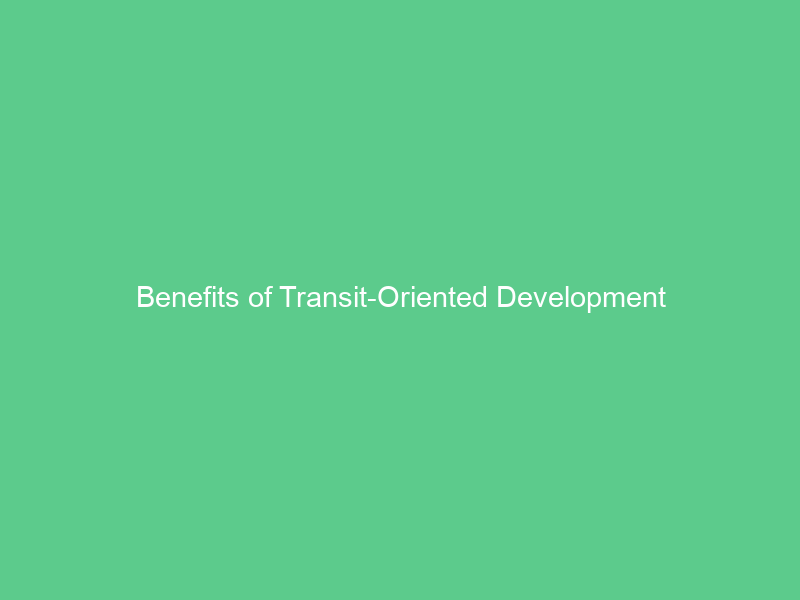Transit-oriented development (TOD), is the concept of creating vibrant and sustainable communities centered on high quality public transit systems. TOD allows people to live life without depending on private vehicles for transportation needs while helping reduce commuting times and costs.
TOD is often associated with rail transit systems; however, its principles can also be applied to bus-only systems. To gain more insight, consult the TOD Design Guidelines.
Concentration of Jobs and Housing
These neighborhoods, located within close walking distance to public transit stations, are designed to foster vibrant local economies with high-quality retail stores and jobs that attract new residents and businesses. Furthermore, TOD communities are affordable to low-income households while also providing access to economic stability for communities of color. However, rapid appreciation associated with TOD developments may contribute to gentrification or displacement and undermine equity goals.
To achieve equitable TODs, it is imperative to consider all potential impacts. A TOD strategy must include strategies designed to preserve and expand affordable housing, combat gentrification and displacement, connect residents to jobs, encourage local small business development, foster economic resilience, and preserve natural areas.
Different factors can impact the social composition of an area surrounding a transit station, including housing prices and supply, floor areas and household sizes, migration flows, age demographics and ethnic diversity. Studies which incorporate all these aspects can produce inaccurate conclusions and misguided policies.
Increased Productivity
Residents in transit-oriented developments tend to rely less on personal cars and work from home more frequently, providing jobs that increase productivity while creating local economic benefits and saving energy costs, maintenance expenses and overall commuting expenses.
Transit-oriented developments offer more than homes and offices; they also feature retail and service amenities within walking distance, helping reduce traffic congestion, greenhouse gas emissions, and parking requirements. These walkable communities can help decrease traffic jams as well as emissions.
Cities looking to implement TOD typically employ zoning codes that promote dense residential structures with higher density such as apartments and condos near transit stations or stops (Cervero et al 2004). TOD neighborhoods typically need at least six residents per acre for areas near light rail, and up to nine residents per acre in highly walkable neighborhoods with excellent sidewalk connectivity and high levels of service (Cervero, et al 2004).
Reduced Carbon Footprint
TOD reduces greenhouse gas emissions and the carbon footprint of cities by consolidating jobs, housing and services around transit stations. As such, TOD encourages people to rely less on private vehicles when travelling for work or other activities, thus decreasing reliance on individual automobiles – thus decreasing greenhouse gas emissions and overall carbon footprint of any given city.
TODs should form part of a comprehensive climate-resilient development strategy, which should also include upgrading public transit systems with clean electricity, reducing auto traffic congestion and investing in amenities that promote non-motorized forms of transport such as biking and walking. Furthermore, equity must be prioritized through policies which ensure low-income residents benefit from new TOD development rather than be displace by it; one such eTOD strategy that could achieve this is creating affordable housing while protecting tenants against rising rents while connecting them to opportunities, jobs and services.
Younger generations like millennials and Gen Z increasingly reject car culture in favor of mass transit as an environmentally friendly and convenient mode of travel. TOD makes achieving this goal simpler by supporting higher density living close to where people want to be.
Enhanced Resilience
TOD creates more resilient cities through its concentration of jobs, housing and community spaces around transit stations. By centralizing economic growth and urban transport in compact neighborhoods that can be reached on foot easily by foot transit systems – such as walkable neighborhoods – TOD helps local economies remain robust even during natural disasters, reduces car traffic emissions significantly and fosters sustainable communities.
Resilience allows individuals to face and overcome challenges and rebound from adverse events with ease. It represents the state that allows a person to cope effectively with stressors and is built upon understanding one’s abilities, strengths, support systems and coping mechanisms.
Equitable TOD (eTOD) is a planning approach with specific strategies designed to achieve equity goals and ensure low-income and residents of color benefit from new development around transit without being dislocated by it. Such strategies may include protecting affordable housing stock, connecting residents to jobs and economic opportunities, slowing property appreciation rates, supporting small and local businesses and more. TOD efforts must adhere to rigorous standards in order to guarantee they produce equitable results.

